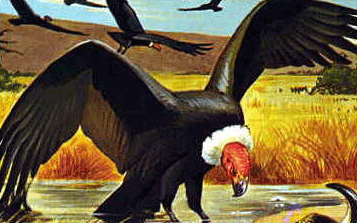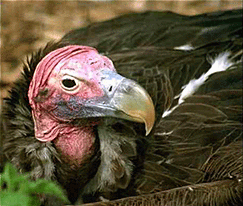Vultures
(the vulture is near extinction in India)

Vultures are being wiped out by the millions
Until recently, vultures were an integral part of the Indian environment. They were so abundant that ornithologists were obviously not aware of their diminishing population.
- Conservationists are now warning that a drug used to treat sick cows is killing the scavenging vultures by the millions.
- The drug is responsible for a 97 percent decline in the species over the past decade from 20 million to 40 million birds 12 years ago, to a figure in the low thousands now.
- The country is facing an ecological disaster of unprecedented proportions.
- Wildlife experts have expressed anger at the government's "lethargic" approach to pushing forward a promised ban on the drug, diclofenac, a cheap painkiller for cattle that is mortally poisonous to vultures.
- This delay is making full extinction of these birds much more likely.
- The ban was promised in March, 2005, and it should have been put in place by now. With the population of these species declining by more than 50 percent a year, there isn't much time left.
- On a warm summer's day above the Timarpur rubbish dump in north Delhi the sky would often be black with hundreds of vultures circling on the warm air currents, looking for cattle carcasses. In the late 1980s scientists believe as many as 3,000 lived around the landfill site.
- With so many of these heavy, ungainly birds in the sky, pilots taking off from Delhi's airports lived in constant fear of vultures smashing into their engines; a number of crashes were linked to the birds.
- The men who used to skin the hide from dead cattle at the landfill site remember having to physically push the crowding birds away as they worked; it would take the vultures less than 20 minutes to strip a carcass clean.
- For tourists to Delhi, the vultures nesting in the ramparts of the Red Fort were an important city landmark.
- Now no vultures are visible at Timarpur or at any of the city's monuments.
- For several years, no one noticed the vultures were declining rapidly because the original population was so large, but by 1995 people began to wonder what was happening.
- In 1997, an alert was issued warning that the species had declined dramatically. Now the birds are classified by the World Conservation Union as "critically endangered"; the category most at risk of extinction in the near future.
- Three species are affected by the poisoning: the oriental white-backed, long- billed and slender-billed vultures.
- Scientists believe that less than one percent of the white-backed population remains and estimate that no more than 200 pairs of the slender-billed vultures survive in the world.
- Normally there was no more than five percent mortality, now there is a rate of 50 percent.
- The cause of the decline mystified scientists, who originally suspected a virus. It was only in 2003 that research in Pakistan revealed that vultures that fed off dead cattle recently treated with diclofenac died swiftly from kidney failure.
- Diclofenac began to be mass- produced in India at the end of the 1980s, and the birds began to die shortly afterward.
- There is a severe inflammation of the guts, bleeding of the intestine and kidney failure, which leads to buildup of uric acid on all the internal organs which causes them to die very quickly.
- With no vultures to clean the carcasses of dead animals, the populations of rats and feral dogs have soared; now they are the main scavengers of rotting meat.
- This has triggered fears of an escalation in the incidence of rabies.
- Amid growing pressure from conservationists internationally, the Indian government made a commitment to ban the drug for veterinary purposes in March, 2005, promising to implement the ban within six months.
- A year later the drug is still freely available and widely used.
- Although the ban was welcomed in the Environment Ministry, it was opposed by officials in the more powerful Agriculture Ministry, who argued that diclofenac was an effective way of treating sick cattle.
- In February, 2006, a group of scientists from South Africa, Britain, Namibia, and India announced that a substitute drug, effective for treating cattle but posing no harm to vultures, had been identified.
- This drug, meloxicam, is not manufactured on the same scale in India as diclofenac; so, it is more expensive; however, wildlife campaigners are optimistic that once demand for the drug increases in the wake of a ban, more companies will start to produce it making it less expensive.
Millions of vultures were flying around just a few years ago

For a long time, the disappearing vultures were not missed
Millions of vultures died in recent years after scavenging from poisoned cattle bodies
The disappearance of the vultures has had serious, unexpected consequences
There is a new medicine which is supposed to be safe, but it is not being utilized
The situation might already have deteriorated to the point of no return. Vultures are large birds, long-living and slow-breeding, and produce an average of just one egg a year. It will take many years for the birds to come back, if ever. Even if there is a proper government ban of diclofenac immediately, it is feared that it is probably already too late to save the vultures.
![]() List of vulture words.
List of vulture words.
